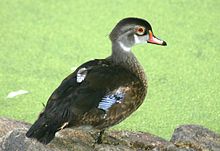Wikipedia:The duck test

The duck test—"If it looks like a duck, swims like a duck, and quacks like a duck, then it probably is a duck"—suggests that something can be identified by its habitual characteristics.
The duck test does not apply to non-obvious cases. Unless there is evidence which proves otherwise beyond a reasonable doubt, editors must assume good faith from others.
Usage
The "duck test" is meant to be used for internal processes within Wikipedia. For example, consider that "User:Example1" is engaged in a heated dispute with someone else, and gets blocked because of it. Immediately after, a "User:Example2" registers on Wikipedia and continues the dispute right away, saying the same things and in the same tone. The duck test allows us to consider it an obvious sock-puppet, and act in consequence. If "User:Example3" then registers and continues the dispute, it is appropriate to escalate sanctions, because the matching behavior is sufficiently obvious to deal with it as sock-puppetry again.
Variations

A variation of the duck test in conversations can be found in community discussions where consensus is required, most obviously Articles for deletion. If consensus appears to be approaching one direction, aside from a handful of accounts that are using the same bad arguments (often "I like it" or "It's just not notable"), it might be reasonable to conclude that, even if direct sockpuppetry is not occurring, the accounts may have still ganged up together.
The duck test may also apply to copyright violations. If there is an image that is clearly a movie or TV screenshot, or magazine or CD cover, licensed as an own work by the author, the duck test would allow us to treat it as a copyright violation, even if the specific source of the image remains unknown. For example, theoretically the actual owner of the movie/CD/whatever copyright might be re-licensing the image GFDL and CC BY-SA to Wikipedia... but the image should be speedily deleted as a copyright violation despite this slim possibility, because there is no need to prove beyond a reasonable doubt that the uploader was not in fact the copyright holder... if so, they can try again via the Open Ticket Request System.
The duck test does not apply to article content, and does not trump, or even stand aside, policies such as no original research, verifiability, and neutral point of view. If there is an animal that "looks like a duck, swims like a duck, and quacks like a duck", but zoologists agree that it does not belong in the family Anatidae, then it is not a duck, period. (That being said, some editors believe that you don't need to cite that the sky is blue.)
See also
- The template {{Duck}}, which appears as
 Looks like a duck to me
Looks like a duck to me - Wikipedia:Avoid the word "vandal"
- Wikipedia:Call a spade a spade
- Wikipedia:Give 'em enough rope
- Wikipedia:You can't squeeze blood from a turnip
- Innocent until proven guilty
- Confirmation bias
- Prejudice
- The purpose of a system is what it does
- Wikipedia:Don't bite the newbies
